
Juan Manuel Fangio, was an Argentine racing driver. Nicknamed El Chueco or El Maestro, he dominated the first decade of Formula One racing, winning the World Drivers' Championship five times.
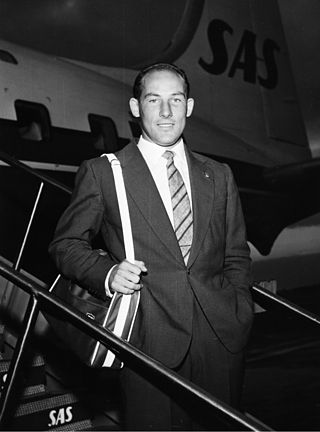
Sir Stirling Craufurd Moss was a British Formula One driver. An inductee into the International Motorsports Hall of Fame, he won 212 of the 529 races he entered across several different motorsports competitions and has been described as "the greatest driver never to win the Formula One World Championship". In a seven-year span between 1955 and 1961, Moss finished in second place four times and in third place three times.

Vanwall was a British motor racing team and racing car constructor that was active in Formula One during the 1950s. Founded by Tony Vandervell, the Vanwall name was derived by combining the name of the team owner with that of his Thinwall bearings produced at the Vandervell Products factory at Acton, London. Originally entering modified Ferraris in non-championship races, Vanwall constructed their first cars to race in the 1954 Formula One season. The team achieved their first race win in the 1957 British Grand Prix, with Stirling Moss and Tony Brooks sharing a VW 5, earning the team the distinction of constructing the first British-built car to win a World Championship race. Vanwall won the inaugural Constructors' Championship in Formula One in 1958, in the process allowing Moss and Brooks to finish second and third in the Drivers' Championship standings, each winning three races for Vanwall. Vandervell's failing health meant 1958 would be the last full season; the squad ran cars in a handful of races in the following years, but finished racing in 1961.
McLaren Automotive is a British luxury automotive manufacturer based at the McLaren Technology Centre in Woking, England. The main products of the company are sports cars, which are produced in-house in designated production facilities. In July 2017, McLaren Automotive became a wholly-owned subsidiary of the wider McLaren Group.
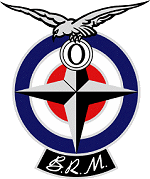
British Racing Motors (BRM) was a British Formula One motor racing team. Founded in 1945 and based in the market town of Bourne in Lincolnshire, it participated from 1951 to 1977, competing in 197 grands prix and winning seventeen. BRM won the constructors' title in 1962 when its driver Graham Hill became world champion. In 1963, 1964, 1965 and 1971, BRM came second in the constructors' competition.
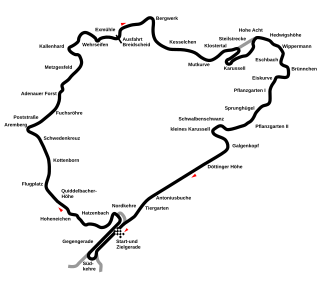
The 1954 German Grand Prix was a Formula One motor race held at Nürburgring on 1 August 1954. It was race 6 of 9 in the 1954 World Championship of Drivers. It was the 17th German Grand Prix since the race was first held in 1926 and the 16th to be held at the Nürburgring complex of circuits. The race was won by 1951 world champion, Argentine driver Juan Manuel Fangio driving a Mercedes-Benz W196. Ferrari 625 drivers Mike Hawthorn and Maurice Trintignant finished second and third for Scuderia Ferrari.

The 1955 Monaco Grand Prix was a Formula One motor race held at Monaco on 22 May 1955. It was race 2 of 7 in the 1955 World Championship of Drivers and was given an honorary name, Grand Prix d'Europe. The 100-lap race was won by Ferrari driver Maurice Trintignant after he started from ninth position. Eugenio Castellotti finished second for the Lancia team and Maserati drivers Jean Behra and Cesare Perdisa came in third.

The 1955 Italian Grand Prix was a Formula One motor race held at Autodromo Nazionale di Monza, in Monza, Italy on 11 September 1955. It was the seventh and final race of the 1955 World Championship of Drivers.
The 1954 Formula One season was the eighth season of FIA Formula One motor racing. It featured the 1954 World Championship of Drivers, and several non-championship races. The World Championship of Drivers was contested over a nine-race series which commenced on 17 January and ended on 24 October 1954. The championship was won by Juan Manuel Fangio, who drove, and won races for both Maserati and Mercedes-Benz throughout the series. Argentine drivers gained the first two positions in the championship, with José Froilán González placing second to his compatriot Fangio.
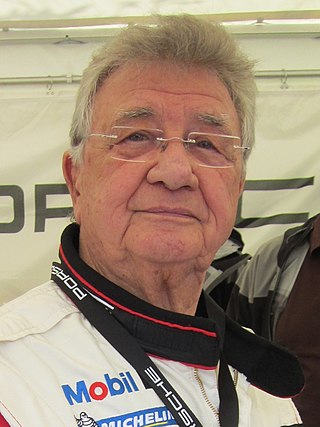
Hans Herrmann is a retired Formula One and sports car racing driver from Stuttgart, Germany.
The British Racing Motors V16 was a supercharged 1.5-litre V-16 cylinder racing engine built by British Racing Motors (BRM) for competing in Formula One motor racing in the immediate aftermath of World War II. Designed in 1947 and raced until 1954–55, it produced 600 bhp (450 kW) at 12,000 rpm, although test figures from Rolls-Royce suggested that the engine would be able to be run at up to 14,000rpm.
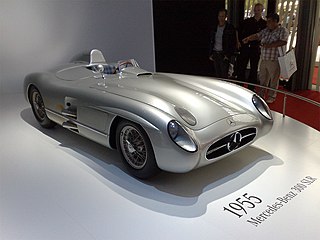
The Mercedes-Benz 300 SLR (W 196 S) is a two-seat sports racing car that took part in the 1955 World Sportscar Championship before a catastrophic crash and fire at Le Mans later that year ended its domination prematurely. The car was designated "SL-R", which was later condensed to "SLR". Technically, the W 196 S is based on the W 196 R, but has a slightly different engine, displacing 3 litres.

The 1955 24 Hours of Le Mans was the 23rd 24 Hours of Le Mans and took place on 11 and 12 June 1955 on Circuit de la Sarthe. It was also the fourth round of the F.I.A. World Sports Car Championship. During the race, a crash killed driver Pierre Levegh and 83 spectators while injuring 120 others in the deadliest accident in motor racing history.

The Maserati 250F was a racing car made by Maserati of Italy used in '2.5 litre' Formula One racing between January 1954 and November 1960. Twenty-six examples were made.

The Ferrari 500 was a Formula 2 racing car designed by Aurelio Lampredi and used by Ferrari in 1952 and 1953, when the World Championship was run to F2 regulations.
Throughout its long history, Mercedes-Benz has been involved in a range of successful motorsport activities, including sportscar racing, touring car racing, Grand Prix racing, and rallying. It is currently active in GT racing, and Formula One.

The Alfa Romeo 158/159, also known as the Alfetta, is a Grand Prix racing car produced by Italian manufacturer Alfa Romeo. It is one of the most successful racing cars ever; the 158 and its derivative, the 159, took 47 wins from 54 Grands Prix entered. It was originally developed for the pre-World War II voiturette formula (1937) and has a 1.5-litre straight-8 supercharged engine. Following World War II, the car was eligible for the new Formula One introduced in 1947. In the hands of drivers such as Nino Farina, Juan Manuel Fangio and Luigi Fagioli, it dominated the first two seasons of the World Championship of Drivers.

Rudolf Uhlenhaut was a British-German engineer, driving engineer for Mercedes-Benz, and the father of Mercedes-Benz 300 SL and 300 SLR. He had a long association with the Mercedes-Benz racing programme of the 1930s and 1950s, and is best known for his road legal Uhlenhaut Coupé version of the 1955 Mercedes-Benz 300SLR race car.
Maserati made four naturally-aspirated, V12 racing engines, designed for Formula One; between 1951 and 1969. The first was an experimental O.S.C.A. engine; in accordance with the 4.5 L engine regulations imposed by the FIA for 1951. Their second engine was 250 F1 V12; in accordance with the 2.5 L engine regulations set by the FIA. Their last two V12 engines were customer engines supplied to Cooper; between 1966 and 1969. The Tipo 9 / F1 and Tipo 10 /F1, which were both manufactured to the FIA's 3.0 L engine regulations for 1966. One sports car, a modified version of the Maserati 350S, also used V12 engine, with a 3.5 L (210 cu in) displacement, and produced 335 hp (250 kW).

The Mercedes-Benz M 196 engine is a naturally-aspirated, straight-8, racing engine, designed, developed, and produced by Daimler-Benz; and used in both sports car racing and Formula One racing, between 1954 and 1955. Daimler-Benz made two versions of the engine, the M 196 R, displacing 2.5 litres, and the M 196 S, displacing 3.0 litres.




















